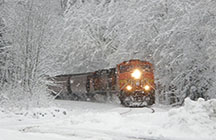 |
 |
|
| eNews • January 2014 | ||
| Promoting a Cost-Effective, Reliable and Competitive Transportation System |
||
 Polar vortex impedes soybean and grain transportation
Polar vortex impedes soybean and grain transportation
The extreme cold weather across the country impeded the transportation and soybeans and grain last week.
Weather-induced delays of rail service between 24-72 hours occurred in many areas of the Midwest. Some railroads already were under stress to accommodate the sizable 2013 harvest. The weather has compounded the problem. Not only can snow and extreme cold weather hamper movement, but it can also cause equipment malfunctions when loading and unloading grain and oilseeds. The weather delays, along with the service delays that were already occurring, have resulted in fewer turns for locomotives and rail cars, which is the equivalent of removing rail assets from a network. A round trip of a unit train of grain from Minnesota or Iowa to the Pacific Northwest is usually 12 days. We are now seeing round trips as long as 18-22 days.
For soybean processors, biodiesel facilities, ethanol facilities, etc. any delay in service is of sizable concern. These facilities are designed to run at full capacity or at least with a consistent throughput that does not fluctuate from day to day. Most deliveries to these facilities occur via truck, which was significantly hampered due to the weather. Most processing facilities are not simply able to make a double batch of product tomorrow if they receive no deliveries today. If a facility can't operate on a particular day, it can be quite difficult to recover from that. It is typical for the Upper Mississippi River (north of Quincy, Illinois) to be closed for barge transportation during December thru late February/early March due to winter weather. However, the Illinois River and the segment of the Mississippi River between Quincy, Illinois, and St. Louis are typically open year round. We witnessed increased ice formation and accumulation in these segments last week. Greater ice accumulation results in a narrowing of the navigation channel. The number of barges that can be lashed together to form a tow or flotilla is reduced. This results in lower efficiency and higher transportation costs. The increasing temperatures late last week are improving the conditions, but it has caused challenges.
An important backdrop to these logistical concerns is the fact that 80 percent of U.S. soybean exports occur between September and February. When the South American soybean harvest comes online during February, March, and April, U.S. soybean exports drop dramatically. Conversely, when the U.S. harvest occurs during the fall, South American soybean exports drop significantly. As a result, when we experience some sort of logistics or transportation delay during this critical period of the year, it causes great concern among U.S. soybean exporters. The soybean industry - given the competitive pressure from South America - does not enjoy the luxury of holding onto a shipment of soybeans for an elongated period of time and then resuming those shipments once the logistical constraint has been addressed without some sort of penalty or cost. While supply chain disruptions during this time of the year are of concern to corn and wheat shippers, these commodities have less competitive pressure from South America and therefore less immediate pressure to move product through the system to the ultimate destination.
Soy Transportation Coalition |
|
